The first 'seeds' are 'sprouting'.
In April 2002, Tim OReilly predicted that the world IT (IT) sector would see an impressive achievement in the field of web applications within five years. He temporarily identified it as WebOS. In the most understandable way, WebOS is a virtual operating system running in a web browser. WebOS can also be viewed as a 'laptop' that doesn't need to be carried around at all times, as it allows use anytime, anywhere and on any Internet-connected computer. WebOS is also known as WOS, Webtop, Web As Desktop, Web Desktop, Virtual Computer or OnlineOS.
This unique technology promises to free users (often working in mobile environments) from the dependence of both hardware and software on physical computers. While waiting for Google to launch Google OS, please share the results of research on the 20 most promising online operating systems (alphabetically arranged). Some of these can be applied immediately. Much of the rest will be useful to developers, creating the basis for WebOS 'made in Vietnam' construction.
1. AJAX WINDOWS
( http://www.ajaxwindows.com )
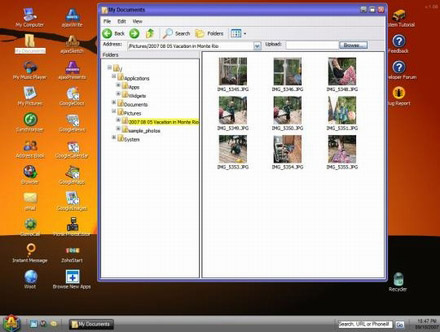
AjaxWindows (AW) has simulated almost everything inherent in a real OS. You will get 'hands-on' through the help dialog. AW allows synchronization of various types of personal data on its physical hard drive with its free 1 GB 'hard drive', such as music, photos, text, folders and even files even wallpaper. In addition, WebOS mentioned above also integrates quite a lot of unique applications, mostly taken from the same product 'furnace' - Ajax13 (http://us.ajax13.com/en/).
AW offers many mini applications (web widgets), helps you browse headlines, see weather forecasts and the like. However, the processing speed is still quite slow. The main screen opens too many child windows, filling the workspace. But overall, they are completely useful. The thing is, if you exploit too many applications at the same time, the computer will run sluggishly and sometimes the system will crash suddenly. AW is the latest application of the WebOS family. Despite being 'rookie', it has covered many essential programs, stable operation and data synchronization - a feature that has not yet appeared in competitors. The only drawback that an AW needs to overcome soon is speed.
2. CRAYTHUR
( http://www.craythur.com )
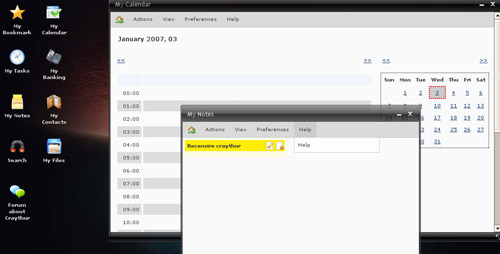
To attract attention, Craythur has invested heavily in the graphical user interface (GUI). The results were initially quite optimistic, similar to Vista's Windows Aero. However, the applications on Craythur are only in the 'internal' phase (alpha test) and the only use is . Spanish! Of course, it all works, but certainly cannot match the other solutions. It is still too early to make a final conclusion about this WebOS because it is at the beginning of the product development cycle.
3. DEKOH
( http://www.dekoh.com )
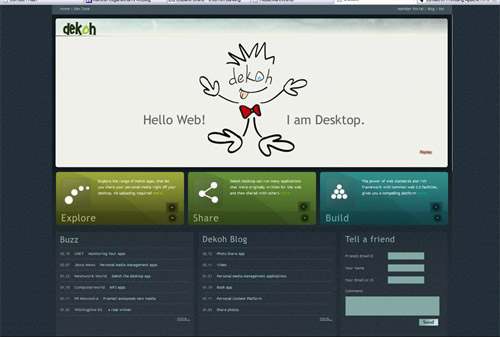
Dekoh is a cross-OS desktop platform, allowing users to share multimedia online. Compared to Adobe's Apollo, Dekoh has a better quality, and fully exploits Java, Ajax or Flash applications on Windows, Linux and Mac OS. There will be no limit on storage capacity and no need to upload data. The reason is simple: Dekoh runs directly from the computer. This principle of WebOS is quite similar to Hamachi - a popular software for sharing local area network (LAN) connections on the Internet.
The interface of the Desktop Portal - the application management center in Dekoh - is very similar to the content management system (CMS) rather than the operating system (OS). You can install, manage individual programs and communicate with other Dekoh users. Its application suite is quite advanced, but the processing speed is problematic, especially the import of music files. Dekoh offers quite a lot of applications. However, the current method of regulating system resources is not stable. Instead of mobilizing all memory capacity when running only one application in the program, Dekoh should separate them into specific processes to reduce RAM pressure.
4. DESKTOP ON DEMAND
( http://www.desktopondemand.com )
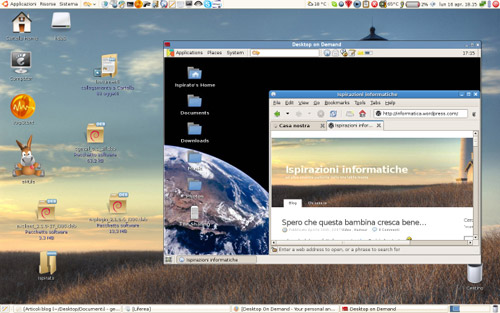
Desktop On Demand (DOD) has brought all of the embedded Linux operating system into the web. For easy visualization, see DOD as a Linux module that runs directly from the CD (Live CD Linux). But it is also because of 'greed' that the DOD has caused a lot of annoyance to users, particularly at the login stage. The most praiseworthy point of the online operating system above is the ability to select integrated applications. You can store data online (get 1 GB for free), surf anonymously (delete traces on 'information superhighway') . The speed of DOD is not high but can be accepted OK. The system is more stable and functional than the Linux Live CD. The competitiveness of this WebOS is quite high because it does not force users to download and install any client software. You are also allowed to switch to using the Java-based version. Overall, DOD's initial performance was cramped but impressed.
5. DESKTOP TWO
( http://www.desktoptwo.com )
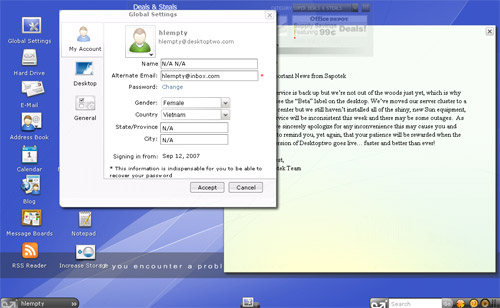
This is an online operating system that runs on Flash, bringing together a lot of popular Web 2.0 applications, such as blogs and e-mail. Desktop Two (DT) also provides many widgets, which help you find information, view calendars and clocks, manage the system, listen to MP3, browse headlines, instant messaging, text editors, web design , write programming code, . However, the speed of DT is slow and often generates errors. In addition, the use of pop-up style windows for each specific application makes the computer very easy to hang or pop the screen. Perhaps DT needs to re-complete the interface in a more friendly way if he wants to become a 'genuine' WebOS.
6. EYE OS
( http://www.eyeos.org )
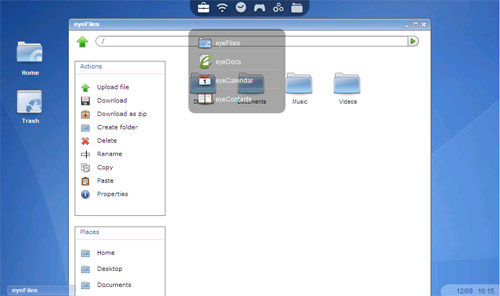
EyeOS is a little different from other WebOS when allowing users to deploy source code on personal servers. You can test the demo on a public server located at eyeos.info. If you don't have your own server, you should sign up for a free account. EyeOS is just at the level of . 'ornamental', has a friendly interface but is a bit slow and has not 'tasted' of stylish OS players. This online operating system provides a number of 'necessities' including calendar, pocket calculator, address book, RSS browser, text editor (primary), data uploader . Of course, it all seems to just . test because the feature is too limited! Some options do not work, such as changing wallpaper. Although ambitious, but with all that shown, no one dares to believe that EyeOS will be a WebOS masterpiece. Even the goal of overcoming the Craythur opponent is already a challenge!
7. GCOE X
( http://www.gcoex.com )
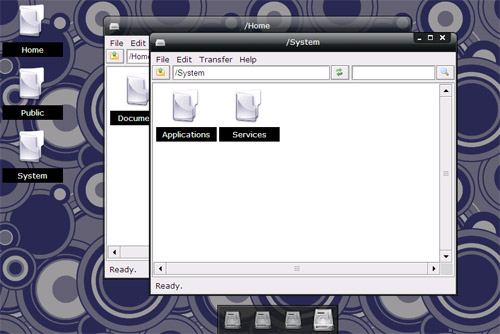
The first solid steps of the GCOE X show that it will be a promising WebOS. Currently, GCOE X only provides basic applications including web browser, MP3 player, instant messenger and command line execution tool. However, the GCOE X runs fast and stable. Even the 'famous' website in terms of the number of Flash ads such as Mtv.com does not "make it difficult" to be integrated by the web browser on the GCOE X. Hopefully the developers will soon add more Another important application.
8. G.HO.ST
( http://g.ho.st/ )
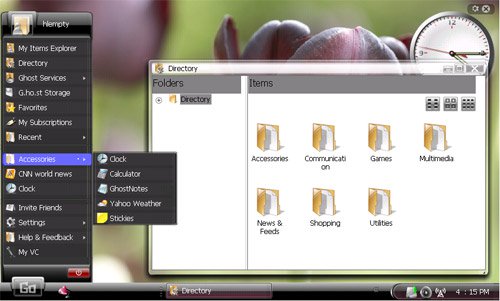
Abbreviated from the Global Hosted Operating System, G.ho.st is also a Flash-based WebOS. It has a graphical user interface very similar to the Microsoft Windows operating system, from 'appearance' to motion, fade / fade out effect and even allows the use of context menus. G.ho.st has also successfully integrated many popular tools including web browser, RSS browser, electronic note label (e-sticker), computer clock, e-mail, message news, search engines, etc. But it does not yet have an office computing suite. However, G.ho.st allows exploiting applications from third parties, such as Google Docs or Flickr. This 'virtual computer' supports a 'one-stop' login mechanism for all its services, and uses a single file system. From now on, you can register for G.ho.st with 3 GB for free (data storage and more webmail coming soon). Overall, G.ho.st works pretty well even though there are errors sometimes when you minimize the application window. If invested more, surely this WebOS will be a big name.
9. GLIDE
( http://www.glidedigital.com )
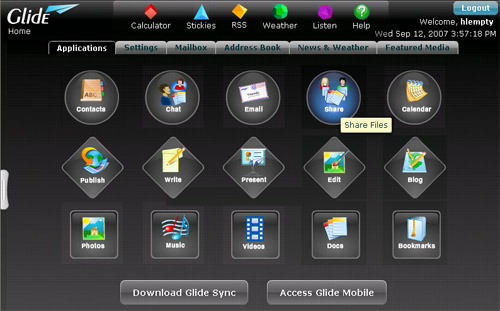
With all that being shown, WebOS's commercial Glide is absolutely worth it when it charges users $ 149.95 / year for the Premium Premium service package. In addition, there are cheaper and even free packages for many different audiences. You can also open an account on Glide by SMS or by the method of authentication of registration information via e-mail.
Glide offers a wide range of popular services, such as uploading and storing online data (up to 1 GB), browsing headlines, managing bookmarks, scheduling tasks, chatting, text editing, webmail, Browse photos, listen to music, watch movies and blog. However, it also has some identical 'diseases'. Desktop Two: opens the program in the form of a pop-up, unevenly invested in the applications for the application and some tools are available but Do not work again! The iconic layout on Glide has many unreasonable points, making it difficult and time-consuming to re-activate an app that has been closed due to wrong clicks! However, because it is a commercial product, this WebOS will definitely improve quickly.
10. GOOWY
( http://www.goowy.com )
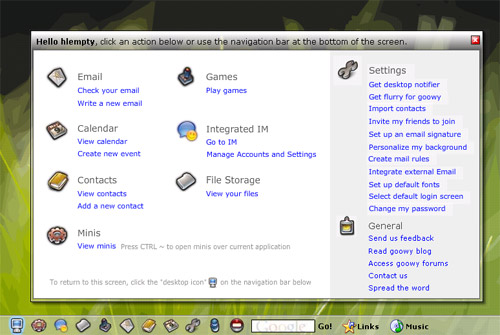
Goowy is a Flash-based WebOS. But during its use, its 'feeling' of Flash does not seem to be clearly shown. The application suite on Goowy is well written and useful. They run not as fast as the wind, but they don't come as slow as cows! Applications will be presented as separate windows and users can move, resize or arrange. The main programs of Goowy are data uploaders, webmail services, RSS browsers, instant messengers, web address bookmarking, calendar and address book. In particular, this online operating system also supports spell checking and spam blocking.
Le Nguyen Bao Nguyen
( Also )
You should read it
May be interested
- The series of pictures revealing the wonders of nature not everyone has the opportunity to admire
 there are countless interesting secrets about nature hidden behind seemingly normal things around us, but not everyone has the opportunity to contemplate. here is a series of photos showing the infinite creativity of nature, helping you to open your eyes offline.
there are countless interesting secrets about nature hidden behind seemingly normal things around us, but not everyone has the opportunity to contemplate. here is a series of photos showing the infinite creativity of nature, helping you to open your eyes offline. - The story of two seeds will help you take the first step to achieving your dreams
 invite you to read the story of the two seeds below - which will help you take the first step to achieving your dreams!
invite you to read the story of the two seeds below - which will help you take the first step to achieving your dreams! - 15+ artistic masterpieces created from avocado seeds
 let us admire 15+ artistic masterpieces created with avocado seeds, which are thought to be just thrown away!
let us admire 15+ artistic masterpieces created with avocado seeds, which are thought to be just thrown away! - Many 5,000-year-old ancient grape seeds are found in Izmir
 a series of ancient ancient grape seeds estimated to be around 5,000 years old have been found in izmir with interesting findings on the margins.
a series of ancient ancient grape seeds estimated to be around 5,000 years old have been found in izmir with interesting findings on the margins. - How to grow mangoes and labels from seeds super fast
 no need to buy plants, you can grow mangoes and labels from seeds very simply by following these steps.
no need to buy plants, you can grow mangoes and labels from seeds very simply by following these steps. - Discover inside the 'apocalyptic underground', the place that holds the seeds of mankind
 an apocalyptic underground, built in norway's land near the arctic, to protect the seeds of nearly every grain around the world to avoid a catastrophe. let's explore inside this underground tunnel!
an apocalyptic underground, built in norway's land near the arctic, to protect the seeds of nearly every grain around the world to avoid a catastrophe. let's explore inside this underground tunnel! - Mold sunflower seeds contain toxins that cause liver cancer
 the frequent presence of aflatoxin, a new toxin produced by aspergillus fungi found in mildew sunflower varieties, may increase the risk of liver cancer especially in low-income countries. many of these foods.
the frequent presence of aflatoxin, a new toxin produced by aspergillus fungi found in mildew sunflower varieties, may increase the risk of liver cancer especially in low-income countries. many of these foods. - 6 How to prepare delicious oats for the elderly and the sick
 the following article, tipsmake.com would like to introduce you 6 ways to make delicious, nutritious bird's nest for the elderly and the sick.
the following article, tipsmake.com would like to introduce you 6 ways to make delicious, nutritious bird's nest for the elderly and the sick. - Walking along with the seven most beautiful magic mountains on earth
 not home, not a cave or any building, seven beautiful magic mountains suddenly sprouting up in las vegas makes the city people ecstatic about everything.
not home, not a cave or any building, seven beautiful magic mountains suddenly sprouting up in las vegas makes the city people ecstatic about everything. - How to get Seed Packets in Grow a Garden
 in grow a garden, in addition to buying seeds at the store, you can also get seed packets by completing daily quests at the tool shop.
in grow a garden, in addition to buying seeds at the store, you can also get seed packets by completing daily quests at the tool shop.










 Common errors when designing websites
Common errors when designing websites To buy a computer like that
To buy a computer like that Spectacular views on Google Sky
Spectacular views on Google Sky The 5 most 'dirty' tricks of malware
The 5 most 'dirty' tricks of malware 'Baggage' is needed to receive the new generation of web
'Baggage' is needed to receive the new generation of web Browse photos quickly in ACDSee
Browse photos quickly in ACDSee